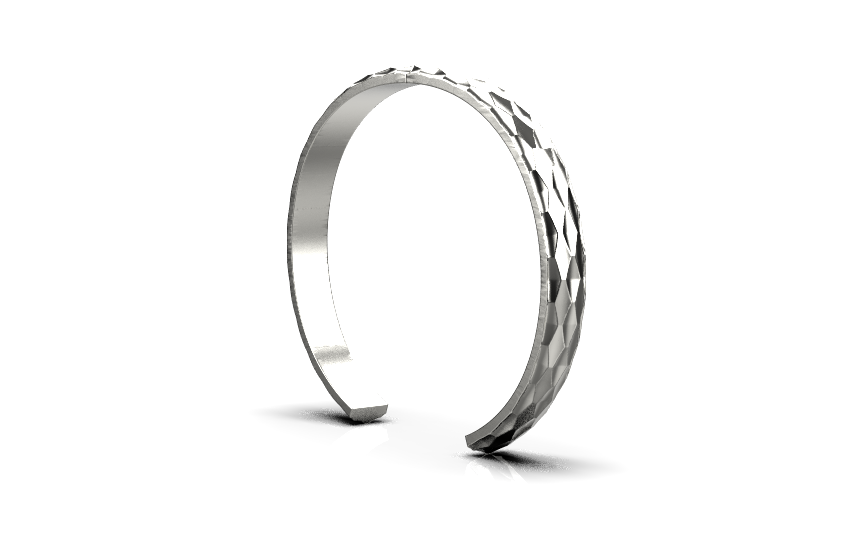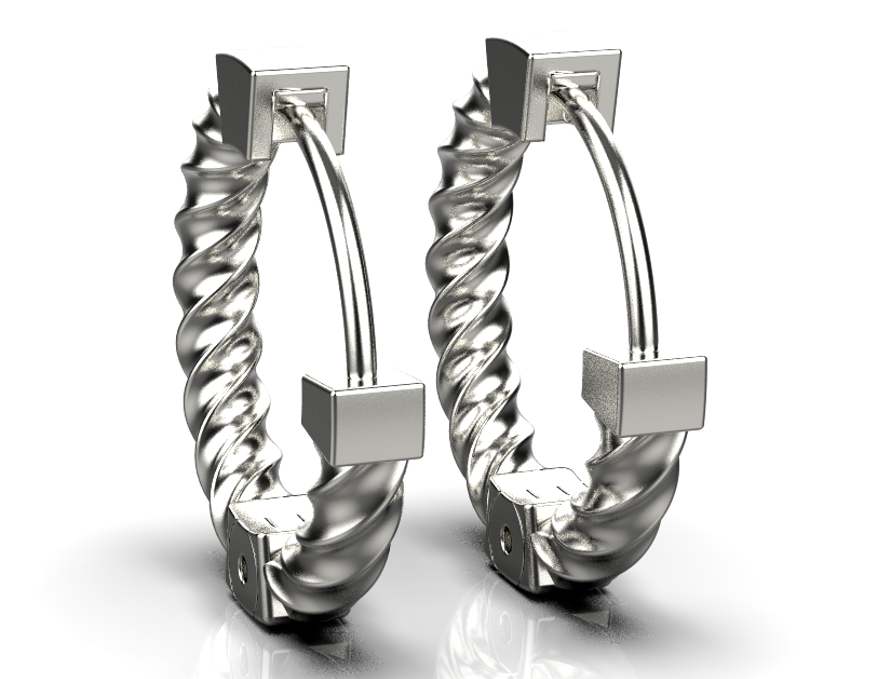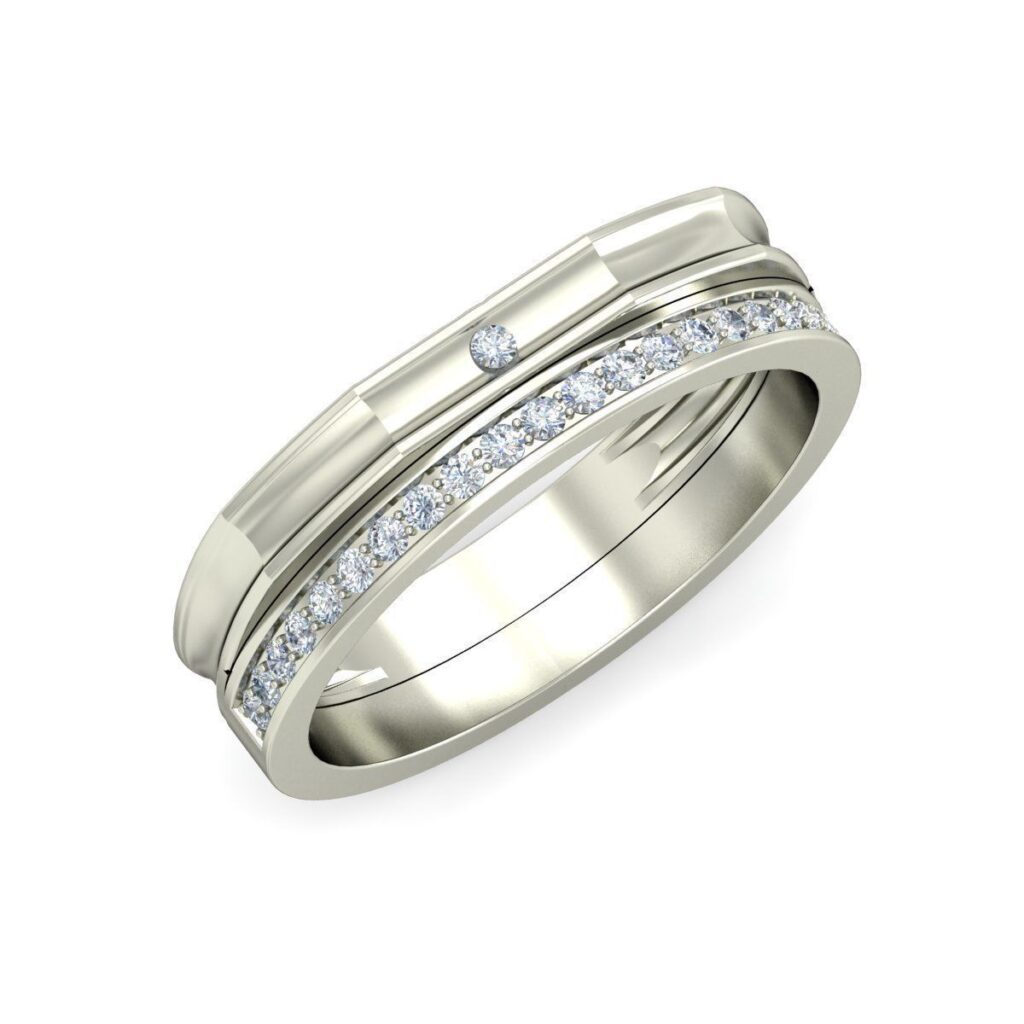Precious Metals
PLATINUM VS SILVER: A COMPARISON OF TWO METALS WITH SIMILAR TONES YET DISTINCT METAL PROPERTIES
A diamond cut is a key factor to consider when choosing your next piece of diamond jewelry.
By Chinwe, Chief Creative Officer
At first glance, Platinum and Silver may share a similar tone, casting a spell of elegance and sophistication. However, a deeper look into their essence, and you’ll discover a fascinating narrative of contrasting metal compositions, each holding its own allure and charm. Silver, revered for centuries for its affordability and versatility, has long been cherished as a precious metal for adorning the body and embellishing objects of beauty. Its malleability and lustrous finish have made it a favorite among artisans and craftsmen, who transform it into intricate designs ranging from classic to contemporary. Platinum, on the other hand, holds a more exclusive allure, prized for its rarity, durability, and purity. As one of the densest and most enduring metals known to man, platinum commands a premium in the world of jewelry, symbolizing enduring love and timeless elegance. In this article, we explore the silver and platinum, delving into their rich histories, unique properties, and diverse applications. We look at :
- History and Significance of Silver and Platinum
- Fitness and Quality and the Impact on Price
- Durability and Wearabilty
- Design and Aesthetics
- Assessing the Quality of Platinum and Silver Jewelry
- Maintenance Guide for Platinum and Silver Jewelry
- Conclusion
History and Significance of Silver and Platinum
Silver
Silver’s history spans millennia, with its use dating back to ancient civilizations such as Mesopotamia, Egypt, and Greece. Revered for its shimmering beauty and malleability, silver was highly prized for crafting ornamental objects, currency, and ceremonial artifacts. Its association with the moon in various cultures imbued it with symbolic significance, representing purity, femininity, and spirituality. As societies evolved, silver played a pivotal role in global trade and commerce. The discovery of vast silver deposits in regions like the Americas during the Age of Exploration transformed economies and fueled imperial expansion.
Silver became a primary medium of exchange, facilitating cross-cultural interactions and shaping the course of history. Beyond its economic value, silver held deep cultural significance in societies worldwide. It was used in religious rituals, folk traditions, and decorative arts, symbolizing purity, prosperity, and protection against malevolent forces. Silver jewelry adorned royalty, nobility, and commoners alike, serving as expressions of wealth, status, and personal adornment. Today, silver continues to captivate with its timeless elegance and versatility. It remains a staple in jewelry making, cherished for its affordability, durability, and ability to complement a wide range of styles. From classic designs to modern interpretations, silver jewelry endures as a beloved accessory, transcending generations and cultural boundaries
Platinum
Platinum’s history is relatively more recent compared to silver, with its discovery credited to Spanish explorers in South America during the 16th century. Initially considered an unwanted impurity in silver mining operations, platinum’s unique properties soon caught the attention of European scientists and artisans. Named after the Spanish word “platina,” meaning “little silver,” platinum began to gain recognition for its rarity, durability, and resistance to corrosion. By the 18th century, platinum had emerged as a symbol of prestige and exclusivity among European royalty and elite circles. Its purity and lustrous appearance distinguished it from other precious metals, elevating its status in the eyes of connoisseurs. During the Industrial Revolution, platinum found new applications in chemical, electrical, and automotive industries, thanks to its exceptional catalytic properties and resistance to high temperatures. Its use in laboratory equipment, dental prosthetics, and catalytic converters further underscored its importance in modern society. platinum became synonymous with luxury and sophistication. It is brilliance, with hypoallergenic properties, and ability to retain its luster over time which make it the metal of choice for engagement rings, wedding bands, and haute couture creations. Today, platinum is a premium in the jewelry market, valued for its rarity, purity, and enduring beauty.
Contrasting the Chemical Composition and Properties of Platinum and Silver
Platinum is a dense, malleable, and ductile metal belonging to the platinum group of elements. Its chemical symbol is Pt, and it boasts an atomic number of 78 on the periodic table. Platinum is renowned for its remarkable resistance to corrosion, making it highly durable and suitable for a wide range of applications. It has a silvery-white color and a lustrous sheen that enhances its aesthetic appeal. Platinum is also known for its high melting point, surpassing 1,700 degrees Celsius, which contributes to its stability under extreme conditions. Additionally, platinum exhibits excellent catalytic properties, making it indispensable in various industrial processes, including chemical synthesis and pollution control.
Silver, represented by the chemical symbol Ag, is a lustrous, soft, and ductile metal with an atomic number of 47. It is a member of the transition metal group and boasts a distinct white coloration that lends itself well to jewelry and decorative applications. Silver possesses excellent electrical and thermal conductivity, making it invaluable in the electronics industry for manufacturing conductive materials and components. Like platinum, silver is highly resistant to corrosion, although it may tarnish over time when exposed to air and certain chemicals. Silver’s melting point is lower than that of platinum, typically around 961 degrees Celsius, but it remains durable and adaptable for various uses.
While platinum and silver share certain similarities in their physical appearance and resistance to corrosion, several key differences distinguish them. Platinum is significantly denser and heavier than silver, with a specific gravity nearly twice that of silver. This density contributes to platinum’s exceptional durability and heft, making it a preferred choice for settings that require strength and longevity. In contrast, silver is more malleable and ductile, allowing for intricate detailing and delicate designs in jewelry making.
In terms of chemical properties, platinum exhibits superior resistance to high temperatures and harsh environments compared to silver. Its exceptional stability and catalytic activity make it indispensable in industries such as automotive manufacturing, where it is used in catalytic converters to reduce harmful emissions. Silver, while also resistant to corrosion, may tarnish over time due to exposure to sulfur compounds and other reactive substances. However, silver’s lower cost and abundance make it a more accessible option for a wide range of applications, from household items to industrial components.
-
Box Chain Necklace – Sterling Silver
Sterling Silver
£450 Select options This product has multiple variants. The options may be chosen on the product page -
Constellation Ring 4.65ct – Platinum
Platinum 950
£7,354 Select options This product has multiple variants. The options may be chosen on the product page -
Dove Brooch – Sterling Silver
Sterling Silver
£280 Add to cart -
Halo Platinum Round Brilliant Cut Wedding Engagement Ring 1.27ct
Platinum 950
£9,500 Select options This product has multiple variants. The options may be chosen on the product page
Fitness and Quality and the Impact on Price
The purity and fineness of silver and platinum play crucial roles in determining the quality and price of jewelry crafted from these metals. Silver jewelry, commonly made from sterling silver, typically contains 92.5% pure silver, alloyed with 7.5% other metals like copper for added strength and durability. This composition ensures that sterling silver jewelry maintains its structural integrity while allowing for intricate designs and styles. Fine silver, with a purity of 99.9%, offers a higher level of purity but is softer and more prone to scratching and tarnishing, often reserved for artisan or specialized pieces.
On the other hand, platinum jewelry is renowned for its high purity and exceptional durability. Platinum alloys, such as 950 platinum, contain 95% pure platinum, with the remaining 5% composed of other noble metals like iridium or ruthenium. This high purity level contributes to platinum’s hypoallergenic properties, resistance to tarnishing, and longevity. Platinum’s density and strength make it an ideal choice for securely setting precious gemstones, ensuring both aesthetic appeal and structural integrity in fine jewelry pieces.
The impact of purity and fineness extends beyond quality to influence the pricing of silver and platinum jewelry. Platinum, being a rare and precious metal, commands a higher price point than silver. Additionally, the higher purity of platinum alloys contributes to its elevated cost compared to sterling silver. While silver jewelry, particularly sterling silver, offers a more affordable option for consumers, platinum’s durability and longevity may justify its higher price tag as a long-term investment.
Durability and Wearabilty
Platinum, renowned for its exceptional durability, is one of the strongest and most enduring metals used in jewelry. Its dense and resilient nature makes it highly resistant to scratches, dents, and tarnishing, ensuring that platinum jewelry maintains its lustrous appearance over time. This durability makes platinum an excellent choice for everyday wear, as it can withstand the rigors of daily activities without losing its shine or structural integrity. Additionally, platinum’s hypoallergenic properties make it suitable for individuals with sensitive skin, minimizing the risk of irritation or allergic reactions.
In contrast, while silver is prized for its affordability and versatility in jewelry making, it is inherently softer and more prone to scratching and tarnishing compared to platinum. Sterling silver, the most common alloy used in silver jewelry, contains other metals like copper to enhance its strength and durability. However, even with these alloys, silver jewelry may require regular maintenance to prevent tarnishing and scratches, particularly when exposed to moisture or harsh chemicals. Despite its relative delicacy, silver jewelry remains popular for its affordability and the ability to create intricate designs and styles.
Design and Aesthetics
The design and aesthetics of platinum and silver jewelry encompass a spectrum of styles and expressions, each influenced by the unique characteristics of these metals.
Platinum, with its brilliant white luster and enduring shine, exudes a sense of timeless elegance and sophistication. Its dense composition allows for intricate detailing and precise craftsmanship, making it a favored choice for creating exquisite and intricate jewelry designs. Platinum’s inherent strength enables jewelers to fashion delicate settings that securely hold precious gemstones, showcasing their brilliance and fire to maximum effect. Whether adorned with classic solitaire diamonds or adorned with intricate filigree patterns, platinum jewelry exudes a sense of luxury and refinement, making it an enduring symbol of enduring love and commitment in engagement rings and bridal jewelry.
Silver, with its cool, lustrous sheen and versatility, lends itself to a wide range of design possibilities, from sleek and modern to ornate and vintage-inspired styles. Sterling silver jewelry, with its understated elegance and affordability, offers a timeless appeal that transcends trends. Its malleability allows for the creation of bold statement pieces as well as delicate, intricately detailed designs. Silver’s reflective properties enhance the sparkle of gemstones, making it a popular choice for fashion-forward designs and everyday accessories. From minimalist stacking rings to bohemian-inspired cuffs and pendants, silver jewelry offers endless opportunities for self-expression and personal style
-
Baguette Eternity Band Ring 0.77ct – Platinum
Platinum 950
£2,376 Select options This product has multiple variants. The options may be chosen on the product page -
Linear Link Chain Necklace – Sterling Silver
Sterling Silver
£550 Select options This product has multiple variants. The options may be chosen on the product page -
Serendipity Bracelet- Sterling Silver
Sterling Silver
£650 Select options This product has multiple variants. The options may be chosen on the product page
Assessing the Quality of Platinum and Silver Jewelry
When deciding on a jewelry piece in platinum or silver, there are several ways to ascertain that what you’d be buying is of the right quality and authentic. The following are some things to look out for:
- Purity and Hallmarks: Platinum jewelry should be stamped with “950 Pt” or “PT950,” indicating 95% pure platinum content. Additionally, reputable platinum jewelry often bears a hallmark from a recognized assay office, such as the International Convention Hallmarking (ICH) system. Look for clear stamps and consider documentation verifying the metal’s purity. For silver, check for stamps like “925” or “sterling,” indicating 92.5% silver content. Ensure the stamp is clear and inspect for additional hallmarks indicating authenticity.
- Weight and Density: Authentic platinum jewelry typically feels heavier than silver due to its high density. Heavier pieces often contain more platinum, indicating better quality. Sterling silver jewelry should still have a substantial weight relative to its size, as it is less dense than platinum. Lightweight pieces may indicate lower quality or insufficient silver content.
- Finishing and Polishing: Platinum jewelry should have a smooth, polished finish with no visible seams or imperfections, showcasing its natural luster and brilliance. Similarly, silver jewelry should exhibit a smooth, polished finish. Some designs may incorporate textures or oxidized finishes for added depth, but avoid pieces with rough or uneven surfaces, as they may indicate poor craftsmanship.
- Workmanship and Detailing: Examine platinum jewelry for intricate detailing and precise craftsmanship, such as secure settings for gemstones and fine engraving or filigree work. High-quality platinum pieces will have clean lines and precise finishes, with no signs of rough edges or solder marks. Likewise, assess silver jewelry for crisp, well-defined details and consistent craftsmanship, paying attention to the setting of gemstones and the overall symmetry of the piece.
- Gemstone Quality and Setting: For jewelry featuring gemstones, assess their quality, clarity, and color. Look for securely set stones with no visible flaws. Platinum’s strength and durability make it ideal for secure gemstone settings, ensuring stones remain in place and protected. Similarly, evaluate the setting of gemstones in silver jewelry, ensuring they are securely held and well-aligned.
By carefully assessing these factors, you can confidently evaluate the quality of platinum and silver jewelry, ensuring that your purchase meets your expectations for authenticity, durability, and craftsmanship.
Maintenance Guide for Platinum and Silver Jewelry
Maintaining the beauty and shine of platinum and silver jewelry requires regular care and attention to ensure they remain in pristine condition. General guidelines for caring for both platinum and silver jewelry include avoiding exposure to harsh chemicals, abrasive materials, and extreme temperatures, as these can cause damage and tarnishing. It’s also important to remove jewelry before engaging in activities that may subject it to impact or abrasion, such as exercising, gardening, or cleaning.
When it comes to platinum jewelry, a gentle cleaning solution can be made using mild dish soap and warm water. Soak the platinum jewelry in the solution for a few minutes, then gently scrub with a soft-bristled brush to remove any dirt or debris. Rinse thoroughly with clean water and pat dry with a soft cloth. Avoid using harsh chemicals or abrasive cleaners on platinum, as these can scratch or damage the metal.
For silver jewelry, regular cleaning is key to preventing tarnishing and maintaining its luster. Silver jewelry can be cleaned using a polishing cloth specifically designed for silver, which will help remove tarnish and restore shine. Alternatively, a gentle cleaning solution can be made using mild dish soap and warm water. Soak the silver jewelry in the solution for a few minutes, then gently scrub with a soft-bristled brush or cloth. Rinse thoroughly with clean water and dry immediately to prevent water spots.
To further protect platinum jewelry from scratches and wear, store it separately from other jewelry pieces in a soft pouch or jewelry box. Avoid storing platinum jewelry in humid or damp environments, as moisture can cause tarnishing over time. Additionally, consider having platinum jewelry professionally polished and inspected periodically to maintain its shine and integrity.
Similarly, silver jewelry should be stored in a dry, cool place away from direct sunlight to prevent tarnishing. Consider using anti-tarnish strips or pouches to help absorb moisture and prevent tarnish buildup. If storing silver jewelry for an extended period, wrap each piece individually in acid-free tissue paper or anti-tarnish cloth to provide an extra layer of protection.
By following these general guidelines and specific care instructions for platinum and silver jewelry, you can ensure that your precious pieces remain beautiful and radiant for years to come, allowing you to enjoy their timeless elegance and charm for generations.
The world of jewelry offers a plethora of choices, but few rival the timeless beauty and enduring elegance of platinum and silver. Whether you’re drawn to the luxurious brilliance of platinum or the affordable versatility of silver, these metals offer something for every style, occasion, and budget. So, why not explore the world of platinum and silver jewelry today? Add a touch of elegance to your collection and let these timeless metals be a reflection of your unique beauty and personality.




